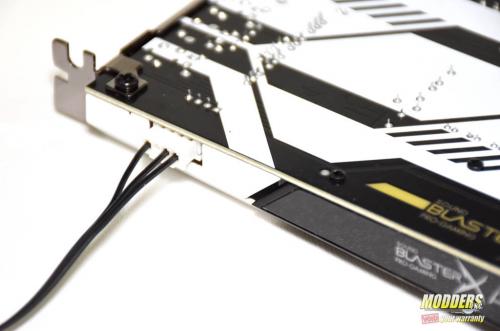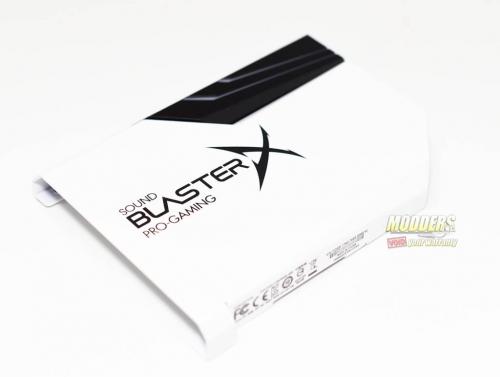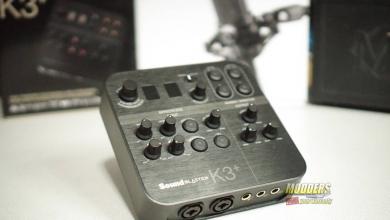A Closer Look at the Sound BlasterX AE-5
My first impressions of the Sound Blaster AE-5 was how good it looks. Where the standard edition has a black shroud, the Pure Edition has a white shroud except for the corner where the RGB lighting is. This part is black.The back of the PCB also has the Sound BlasterX logo with RGB back lighting. In addition, the back is painted, predominantly white, with a very distinct pattern on it in black. At first, I thought the AE-5 had a back plate. However, after a closer look, I realized the back of the PCB was simply painted. I love the design on the back of the AE-5. Also, being black and white, it’ll easily fit into just about any color scheme in any system.
The bottom has the standard PCIe connector. This is also where you find the serial number for the card. The Sound BlasterX AE-5 is the worlds first sound card with a discrete RGB controller built in. We find the connector for the RGB controller on the top of the card, near the I/O. The sample we reviewed was the AE-5 Pure Edition which comes with four RGB strips that daisy chain together. Each RGB strip is 30 cm in length and has 10 LEDs. The standard edition comes with one RGB strip. To the right of the RGB controller, we see the Sound BlasterX AE-5 logo, with RGB backlighting.
The I/O consists of five 3.5mm jacks, all of which are gold plated. They are a line in/mic in, headphone jack, a SPDIF optical port and 3 dedicated to a 5.1 surround sound. One port for the front speakers, one for the rear and the third for a subwoofer. The rear of the card has a front panel HD Audio header and a Molex connection. The Molex connection powers the discrete RGB controller.
When tearing down the card, the first step is removing the bracket at the front of the card, covering the I/O. After that, there are a series of screws near the Sound BlasterX logo on the back plate that must be removed. This will remove the top cover and expose the PCB. Now, we can really see what this card is made of, literally.
Once the shroud is removed, we see the PCB is all its glory. To remove the shroud, there are a total of 7 screws that need to be removed first. There are four smaller screws near the Sound BlasterX logo, and three larger screws near the I/O, including 2 that help secure the I/O bracket.
On the top, the right side of the PCB, there are 5, very bright RGB LEDs, as well as a light panel, also RGB. One the back of the PCB, there is the Molex connection to power the RGB controller, as well as the front panel HD audio connector. Near the center, you can see the ESS Sabre audio processor chip. This is just one of the many premium, audiophile-grade components that make up the components on the PCB of the AE-5. The quad-core Sound Core3D audio DSP and the legendary Sound Blaster technologies provide fully customizable DSP-powered audio enhancements, crystal-clear vocal reproduction, in-game voice communication enhancements, 7.1 virtual surround sound and other advanced audio technologies
The Sound BlasterX AE-5 has a 122 decibels Sabre-Class DAC with a THD, or total harmonic distortion of 0.00032%. This is 1-2 decibels higher than the onboard audio of the average high-end motherboard. For example, the AORUS Z370 Gaming 7 has a 121 decibel DAC. However, there are many more benefits to using a discrete sound card over onboard audio.
One of the best features of the AE-5 is its all-new XAMP headphone amp. The average headphone amp has one amp for each channel. However, the XAMP headphone amp gives each channel its own dedicated amplifier. The XAMP has an ultra-low impedance of 1Ω. This makes the AE-5 capable of driving high-end, studio-grade headphones, as well as sensitive headphones or in-ear monitors from 16Ω to 600Ω.
“The quad-core Sound Core3D audio DSP and the legendary Sound Blaster technologies provide fully customizable DSP-powered audio enhancements, crystal-clear vocal reproduction, in-game voice communication enhancements, 7.1 virtual surround sound and other advanced audio technologies.”
































